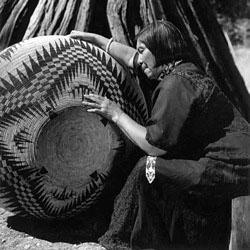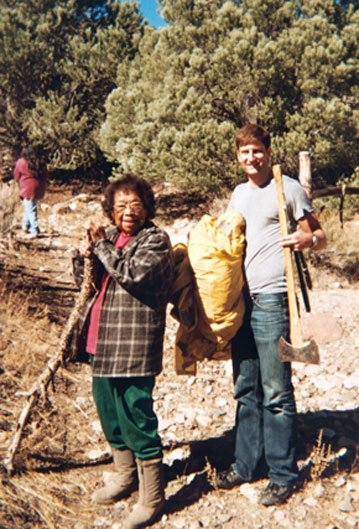Northern Paiute
The traditional Northern Paiute language area is from Mono Lake, north and west through Nevada and up into Oregon and Idaho. There are two communities of Northern Paiute speakers in California, one at Mono Lake and to the immediate north (around Bridgeport and Coleville, California and Sweetwater, Nevada), the other around Susanville, California. In pre-contact times, Northern Paiute speakers in California probably numbered no more than 600 (Kroeber 1925). In the 21st century, there are about 300 first-language speakers throughout the United States (Golla 2011).

Northern Paiute (also called “Paviotso”) is a member of the Numic branch of the Uto-Aztecan language family. Within Numic, it is most closely related to Mono and more distantly to Panamint, Shoshone (spoken in Nevada, Idaho, Utah, and Wyoming), Comanche (spoken mainly in Oklahoma, Texas, and Arizona), Kawaiisu, and Chemehuevi-Southern Paiute-Ute. The other Uto-Aztecan languages of California are Tubatulabal and the Takic languages (Cahuilla, Cupeño, Gabrielino, Juaneño, Kitanemuk, Luiseño, Serrano, and Tataviam).
Grammatical information
Northern Paiute is a language with subject-object-verb word order. It is agglutinating and, for the most part, suffixing. Its phonemic inventory is small: five monophthongal vowels with a binary length distinction, plus the Numic “sixth vowel” (a long vowel with a variable realization anywhere from the diphthong [ai] to the monophthong [e]) and 21 consonants in the northern dialects of Oregon and Idaho. In the southernmost dialect spoken near Mono Lake, there are 24 consonants. The different stems form a typologically interesting three-way distinction in the stop inventories (lenis—fortis—voiced fortis) that has been collapsed into a two-way distinction (lenis—fortis) in all dialects north of central Nevada. Word-level stress is largely predictable, almost always falling on the second mora. Morphologically, Northern Paiute shares many of the unique features of the Uto-Aztecan language family. Like other Numic languages, the first consonant of a morpheme is subject to mutation. It varies between lenis and fortis (and voiced fortis in the southern dialects) realizations with the identity of the preceding morpheme — an alternation that is synchronically arbitrary. Most nouns must bear one of a set of absolutive suffixes when they are not possessed or part of a compound, a feature that Northern Paiute shares with the rest of Uto-Aztecan. It also has a productive inventory of instrumental prefixes, formatives that occur on verbs to describe the instrument with which some activity was carried out (often a body part, such as the head or fist).
Selected archival materials at Berkeley
Selected materials in other archives
Further reading
- Golla, Victor. 2011. California Indian languages. Berkeley: University of California Press.
- Haynes, Erin Flynn. 2010. Phonetic and Phonological Acquisition in Endangered Languages Learned by Adults: A Case Study of Numu (Oregon Northern Paiute). Ph.D. dissertation, University of California, Berkeley. [PDF]
- Liljebad, Sven. 1966. Northern Paiute manual I: Grammatical sketch of the northern dialects. Boise, ID: Department of Anthropology, Idaho State University.
- Liljebad, Sven, Catherine S Fowler & Glenda Powell. 2011. Northern Paiute–Bannock Dictionary. University of Utah Press.
- Marsden, W. L. 1923. The Northern Paiute Language of Oregon. United States: Coyote Press. [PDF]
- Nichols, Michael Porter. 1974. Northern Paiute historical grammar. Ph.D. dissertation, University of California, Berkeley.
- Snapp, Allen, John L. Anderson, and Joy Anderson. 1982. Northern Paiute. In Ronald W. Langacker, ed. Studies in Uto-Aztecan grammar 3: Uto-Aztecan grammatical sketches, Part 2, pp. 1-92. Dallas, TX: Summer Institute of Linguistics and the University of Texas at Arlington. [PDF]
- Thornes, Timothy Jon. 2003. A Northern Paiute grammar: With texts. Ph.D. dissertation, University of Oregon.
- Thornes, Tim & Toosarvandani, Maziar. 2020. Texts in the Indigenous Languages of the Americas: Northern Paiute Texts across Varieties. International Journal of American Linguistics, 86:S1. [PDF – may not be publicly available]
- Yerington Paiute Tribe. 1987. Paiute-English English-Paiute dictionary. Anchorage, AK: Bilingual Education Series.
Links

- Confederated Tribes of Warm Springs
- Fort Independence Indian Reservation
- Northern Paiute Language Project
- Pyramid Lake Paiute Tribe
- Reno Sparks Indian Colony
- Shoshone-Bannock Tribes
- Shoshone-Paiute Tribes of the Duck Valley Indian Reservation
- Summit Lake Paiute Tribe
- Walker River Paiute Tribe
- Yerington Paiute Tribe
- Glottolog: Northern Paiute
- OLAC Resources in and about the Northern Paiute language
- World Atlas of Language Structures: Northern Paiute